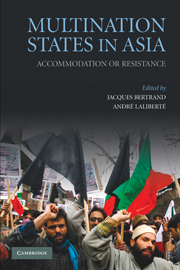Book contents
- Frontmatter
- Contents
- List of Tables and Figures
- List of Maps
- List of Contributors
- Acknowledgments
- Maps
- 1 Introduction
- 2 Revolutionary State Formation and the Unitary Republic of Indonesia
- 3 The Crisis of Border States in India
- 4 Pakistan: Neither State Nor Nation
- 5 Constitutional Politics and Crisis in Sri Lanka
- 6 The Dilemmas of Burma's Multinational Society
- 7 The Double-Edged Sword of Autonomy in Indonesia and the Philippines
- 8 China and the Virtual Taiwan Nation
- 9 The Failure of Ideologies in China's Relations with Tibetans
- 10 Leninism's Long Shadow in Central Asia
- 11 Conclusion
- References
- Index
1 - Introduction
Published online by Cambridge University Press: 05 June 2012
- Frontmatter
- Contents
- List of Tables and Figures
- List of Maps
- List of Contributors
- Acknowledgments
- Maps
- 1 Introduction
- 2 Revolutionary State Formation and the Unitary Republic of Indonesia
- 3 The Crisis of Border States in India
- 4 Pakistan: Neither State Nor Nation
- 5 Constitutional Politics and Crisis in Sri Lanka
- 6 The Dilemmas of Burma's Multinational Society
- 7 The Double-Edged Sword of Autonomy in Indonesia and the Philippines
- 8 China and the Virtual Taiwan Nation
- 9 The Failure of Ideologies in China's Relations with Tibetans
- 10 Leninism's Long Shadow in Central Asia
- 11 Conclusion
- References
- Index
Summary
Multination states have been unstable. The presence of more than one group seeking status as a “nation” within the boundaries of a single state has given rise to strong tensions that have generally been difficult to overcome. The means by which these tensions are addressed and the instruments available for seeking compromises between states and such groups largely determine the extent to which violence can be avoided.
In the worst cases, the world has witnessed long periods of violent conflict. The breakup of the former Yugoslavia and the subsequent war, as well as the long-standing conflict in Sri Lanka are two of the most glaring examples. More often than not, one group gains control of the state and imposes its own view of an overarching national identity. This is rejected by the other group, which sees itself as a distinct nation. The conflict often takes the form of a sub-state nationalist movement against the state, but in reality it reflects intense disagreements based on competing nationalist visions. While one group may make strong claims that the state represents a single nation that can be defined inclusively, it may clash with a group within the state that refuses to be encapsulated within that vision. As happened in Sri Lanka, such a single nation might even exclude a group entirely by defining itself in cultural, exclusivist terms.
Information
- Type
- Chapter
- Information
- Multination States in AsiaAccommodation or Resistance, pp. 1 - 28Publisher: Cambridge University PressPrint publication year: 2010
Accessibility standard: Unknown
Why this information is here
This section outlines the accessibility features of this content - including support for screen readers, full keyboard navigation and high-contrast display options. This may not be relevant for you.Accessibility Information
- 1
- Cited by
